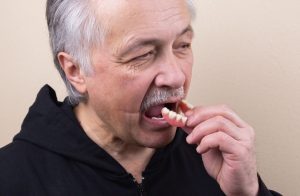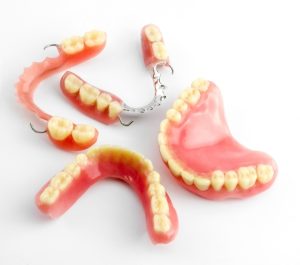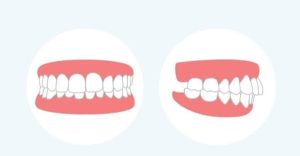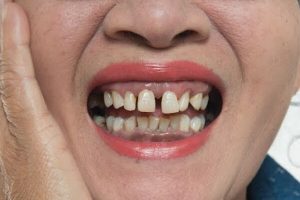Table of content
An open bite is one of the common types of malocclusion, affecting not only facial aesthetics but also causing significant issues with oral health, chewing function, and speech. However, very few people are aware of the condition of an open bite, which often leads to delays in treatment. In the following article, Elite Dental will help you understand more about the characteristics, causes, and effective methods for correcting an open bite.
1. What is an open bite?
An open bite is a condition where the upper and lower front teeth do not come into contact with each other. Specifically, the front teeth cannot close tightly, and the tongue can be seen even when the mouth is fully closed or in a resting state.
There are two types of open bites:
- Anterior open bite: This occurs when the upper front teeth cannot make contact with the lower front teeth.
- Posterior open bite: This happens when the back teeth (including molars and premolars) do not touch each other when biting down.
2. Characteristics of an Open Bite
To identify an open bite, individuals can look for the following characteristics:
- The upper and lower front teeth, including incisors, canines, and premolars, do not come into contact with each other, creating gaps at the front.
- The upper front teeth form a characteristic V-shaped arch.
- A mild open bite can lead to protruding teeth, causing noticeable angles in the profile line from the forehead to the nose and chin.
- There may be discomfort or pain when biting or chewing food.
View more: What is a crossbite? Signs, causes, and treatment options
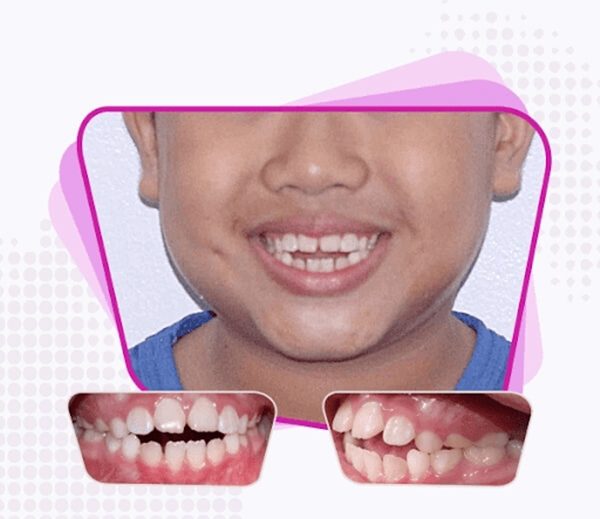
3. Causes of an Open Bite
The condition of an open bite can arise due to abnormal development of the jawbone structure related to genetic factors, poor oral habits, and other issues. Specifically:
3.1. Genetic Factors
Family genetics can lead to misalignment of the teeth and jawbone. Intervention is typically considered only after the open bite becomes clearly noticeable and the tooth structure has fully developed.
3.2. Structural Bone Defects
This occurs when the upper or lower jawbone is too narrow or recessed, preventing the formation of a complete bite.
3.3. Poor Childhood Habits
Habits such as tongue thrusting, thumb sucking, pencil biting, or prolonged use of pacifiers during the tooth development phase can disrupt normal alignment and lead to an open bite.
4. How an Open Bite Affects Your Health
An open bite can lead to various complications affecting dental, oral, and overall health, such as:
4.1. Impaired Tongue and Lip Function
An open bite can disrupt the normal movement of the tongue and lips, leading to speech difficulties and pronunciation problems, such as a lisp.
4.2. Reduced Chewing Efficiency
The ability to chew is diminished because the bite does not distribute force evenly. This can result in digestive issues due to inefficient food breakdown.
4.3. Temporomandibular Joint Disorder (TMD)
Excessive force applied by the jaw to chew or bite food can strain the temporomandibular joint, potentially causing TMD and related discomfort.
4.4. Facial Imbalance
Individuals with an open bite often have an uneven facial appearance, with misaligned features that can cause self-consciousness and hesitation when talking or smiling.
4.5. Oral Hygiene Challenges
An open bite makes it difficult to maintain oral hygiene, increasing the risk of bacterial growth and dental problems such as cavities, gum disease, and gingivitis.
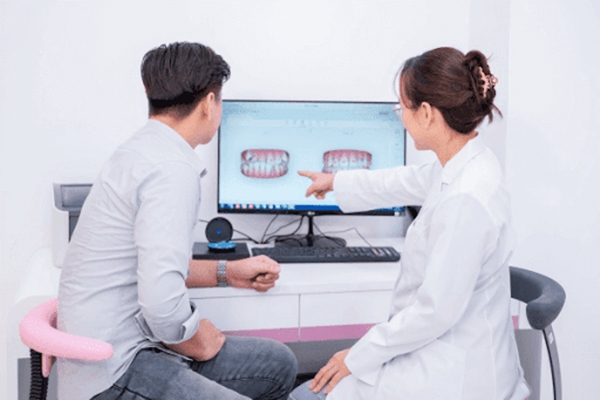
5. How to Treat an Open Bite?
To effectively treat an open bite, it is crucial to identify the underlying cause of the condition. Depending on the situation and the cause, the dentist will apply the appropriate treatment method to correct the bite and align the teeth properly.
Did you know that achieving an attractive smile involves more than just a natural smile line? A properly aligned bite is crucial for not only aesthetics but also for optimal chewing function, long-term oral health, and the overall eating experience. So, what exactly is a proper bite? Let Elite Dental…
5.1. Initial Stage of Open Bite Formation
For children with an open bite caused by daily habits during their developmental stage, dentists may use specialized appliances such as tongue restrainers to help the child stop these habits.
If the open bite is due to jawbone issues, the patient may be prescribed expanders to widen the dental arch and help the upper and lower jaws align properly.
Note: The initial stage of an open bite is the optimal time to consult an orthodontist for timely intervention. Early intervention can help quickly and effectively correct the misalignment. Parents should also monitor and correct the child’s bad habits and promote healthy habits, including proper oral hygiene.
In this stage, treatment will involve two phases:
- Bone Adjustment: Using necessary orthodontic appliances to correct the open bite and achieve proper occlusion.
- Detailed Tooth Alignment: Aligning the teeth accurately to ensure a proper bite and straight teeth.
5.2. Established Open Bite
In this stage, there are three different methods to treat an open bite: braces, dental crowns, and jaw surgery. Among these, braces are the most commonly used and optimal method. Braces use specialized appliances such as brackets, wires, and aligners to apply force to move the teeth into the desired position, achieving proper bite and aesthetic harmony without negatively affecting the natural tooth structure. For more information on achieving beautiful dental crowns, click HERE.
Currently, there are two types of braces for treating an open bite: traditional metal braces and clear aligners.
Traditional Braces
The dentist will attach brackets to the teeth and use wire adjustments to reshape the bone within the tooth socket, moving the teeth into the correct bite. Additional methods such as archwires, screws, rubber bands, and tooth extraction may be required. The orthodontist will provide detailed advice based on your specific case during the examination.
Clear aligners
This modern orthodontic method uses clear aligners designed for each individual’s dental structure. These aligners fit snugly over the teeth and apply gentle force to move the teeth into the desired position. The orthodontist will create a treatment plan to produce a series of aligners for you to wear, and will also perform any additional necessary treatments such as screws or rubber bands.

6. Correcting Open Bite at Elite Dental for a Comfortable Experience
Orthodontics is a complex technique, and open bite is a serious malocclusion that requires a highly skilled and experienced orthodontist to understand the condition of the teeth and jaw and develop an accurate treatment plan.
Many cases of open bite treated at Elite Dental have successfully restored beautiful smiles and proper occlusion. With a team of orthodontists boasting over 10 years of experience in both traditional braces and Invisalign, our specialists create precise and effective treatment plans tailored to each patient. They monitor the orthodontic process closely and provide timely support to ensure that teeth move according to the planned course, delivering results with well-aligned teeth, correct occlusion, and harmonious facial aesthetics.
Additionally, Elite Dental is equipped with advanced European-imported technology such as the 3D Trios scanning system, Sirona X-ray machines, and state-of-the-art orthodontic treatment rooms. These tools expedite the treatment process and help minimize discomfort, ensuring a smooth and gentle orthodontic experience for our patients.
Here are some successful open bite treatments at Elite Dental:
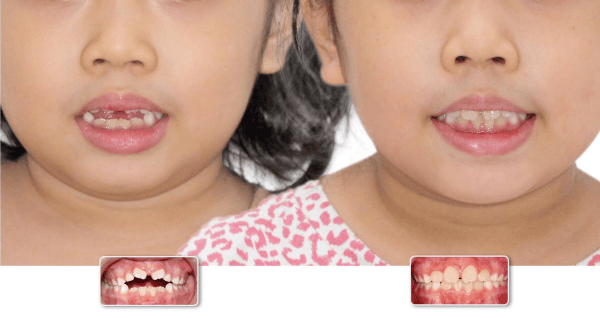
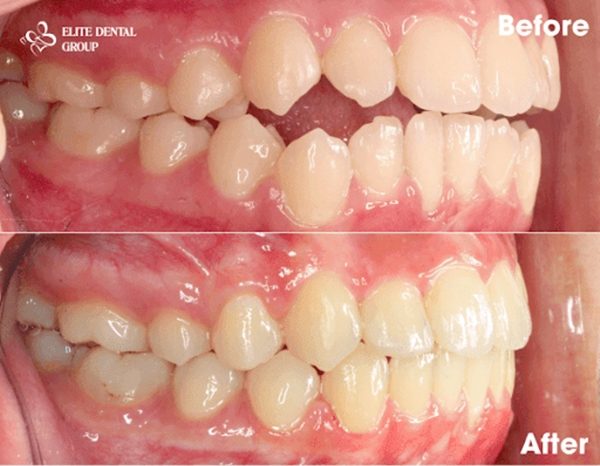
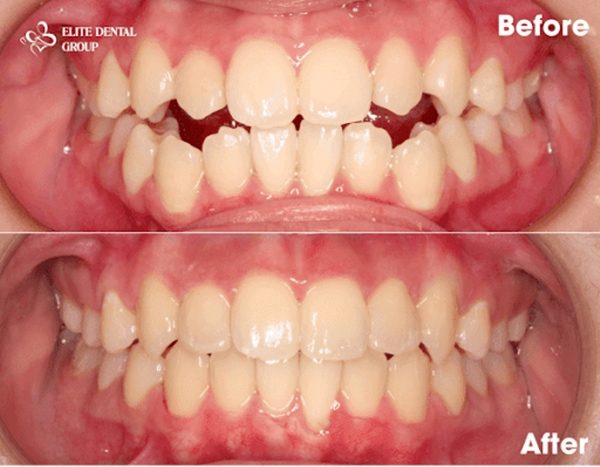
There are many other successful cases of correcting bite discrepancies at Elite Dental. With extensive experience and dedication, our doctors will accompany you on the journey to restore your bite and achieve exceptional facial aesthetics. If you notice any signs of an open bite, don’t hesitate to contact Elite Dental, a trusted dental clinic, to begin treatment as soon as possible and achieve the best results!
COSMETIC & ORTHODONTIC DENTISTRY CENTER
75 Huynh Tinh Cua, Ward Vo Thi Sau, District 3, HCMC
info@elitedental.com.vn
Hotline: (+84) 28 7306 3838 – (+84) 902661100
Related posts: > Deep Bite: What is it, causes, and treatment options > Can braces and Invisalign correct an overbite (overjet)? > Is it possible to fix spaced teeth with braces?



